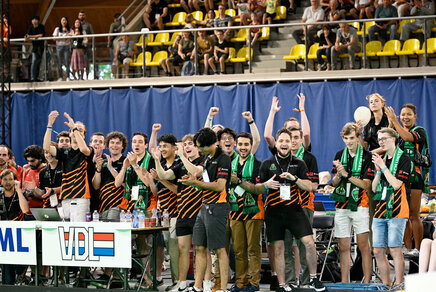Computer models of wind turbine fatigue
Feiyu Geng defended his PhD thesis at the Department of Built Environment on November 24th.

The use of wind energy is vastly increasing across the world, creating huge challenges at technical, industrial, and political levels. The fast growing demand for wind energy has led to a wide variety of wind turbine designs. A specific contemporary type is the vertical-axis wind turbine, whereby the straight or curved bladed rotor is oriented vertically, and thus perpendicular to the wind direction. For his PhD research, Feiyu Gene studied the lifetime of these turbines, paying particular attention to rotor aerodynamics and fatigue failure.
There are a large number of wind turbine designs available, such as the vertical-axis wind turbine (VAWT), where the generator and gearbox are placed at the base of the turbine.
Unlike the more popular horizontal-axis wind turbines (HAWTs), VAWTs can harness wind from any direction, and can be applied in both offshore and the urban environment, producing clean energy for homes, businesses, and farms.
However, in the past two to three decades VAWTs have not received the same amount of research and development effort as HAWTs. Furthermore, the blades of VAWTs are prone to fatigue damage caused by the cyclically aerodynamic loading under a large variation of the incidence angle of each blade relative to the wind direction.
Lifetime and simulations
For his PhD research, Feiyu Geng studied the lifetime of VAWTs, focusing on rotor aerodynamics and fatigue failure mechanisms in particular to gain a better understanding of VAWTs.
During the operation of VAWTs, Geng and his collaborators discovered that the large variation of the incidence angle of the blade relative to the wind direction may result in strong fluctuations in the flow properties (velocity, pressure) at the blades. Resulting turbulence effects induce a phenomenon called “deep dynamic stall”, which may have a large influence on the lifetime of turbine blades.
High-fidelity computational fluid dynamics (CFD) simulations were performed by Geng to quantify the essential flow properties at the blades and to determine the aerodynamic loading on the wind turbine.
The results from this part of Geng’s study serve as a guideline for the further improvement of wind tunnel experiments and CFD simulations for blades subjected to deep dynamic stall.
Cracks
In a second part of the research, a high-cycle fatigue interface damage model was developed that can be used for simulating the VAWTs’ fatigue life.
This fatigue model elegantly enables the simulation of crack initiation and propagation in a computationally efficient and accurate way, accounting for mixed-mode loading conditions and fatigue loading of variable amplitude.
Fatigue model
The third part of Geng’s thesis combines CFD simulations with the high-cycle fatigue model to obtain an advanced computational modeling framework for the determination of the lifetime of real VAWTs operating in the built environment.
This framework allows for the simulation of high-cycle fatigue cracking processes in the wind turbine in an accurate and robust fashion and at manageable computational cost, thereby providing an analysis tool that can be used for improving the durability and reliability of VAWTs, particularly regarding understanding and mitigating fatigue damage.
Title of PhD thesis: Lifetime prediction of vertical-axis wind turbines based on CFD simulations and high-cycle fatigue modelling. Supervisors: Akke Suiker, Bert Blocken, and Hamid Montazeri.
Media contact
Latest news

![[Translate to English:] [Translate to English:]](https://assets.w3.tue.nl/w/fileadmin/_processed_/7/7/csm_Banner%20image%20Woonbedrijf%20-%20Vestide%20-%20Haven%20TUe%20Campus%20-%20Drone-3_4876c53b3c.jpg)
![[Translate to English:] [Translate to English:]](https://assets.w3.tue.nl/w/fileadmin/_processed_/e/e/csm_TUe%20Veni%20Grants%20photos%201920x1080%20px_398dab1f6d.jpg)